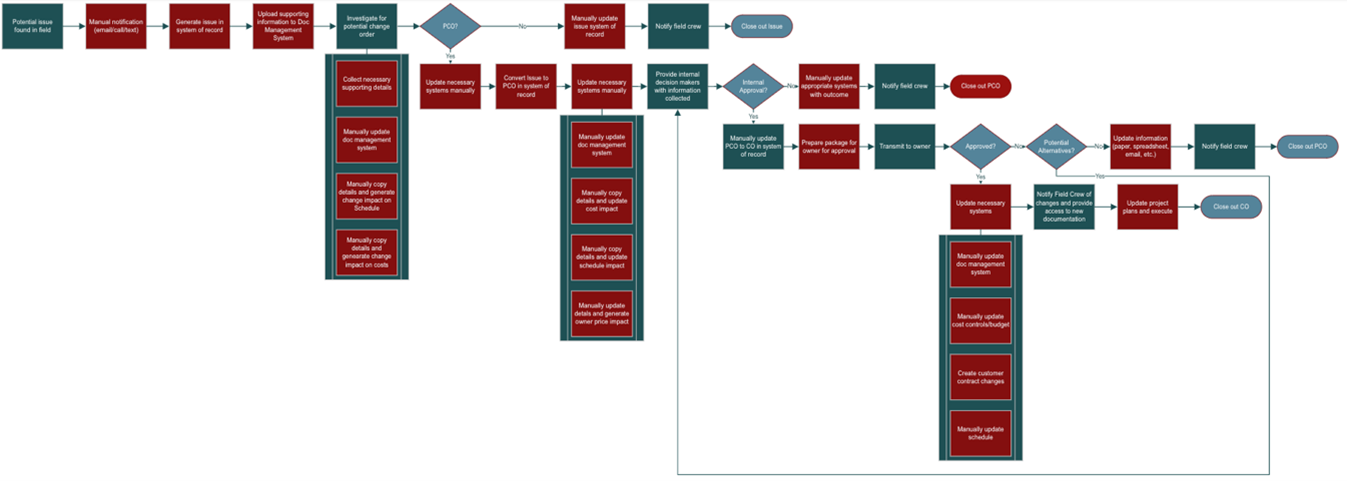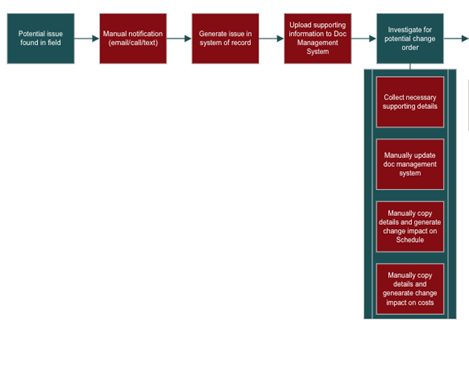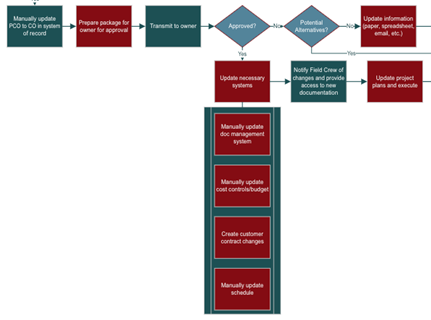Ever play the telephone game? That’s the one where you whisper something to a person next to you, they to the person next to them, and so on until it gets back to the person on your other side, and they say it out loud. You repeat your original statement out loud, and everyone gets a good laugh because it is almost never correct. It’s usually funny in that context.
In the context of capital and construction project management, however, it can quickly become costly and even dangerous.
While it’s not whispering a secret phrase along the line until the work is done, there are countless processes in the construction world that require inputs from other, disconnected tools and processes. This telephone game can quickly get expensive and dangerous. The good news is that we have the technology to eliminate those potential points of error while also speeding up the overall business processes involved.
The Only Constant Is Change (Management)
I wonder if Heraclitus was involved in any of the giant construction projects in ancient Greece when he coined this phrase? It certainly fits the world we work in now with capital project and construction management. Since change management is a process that we have all dealt with, and there are so many roles involved with it happening correctly, it makes a great candidate to explore how technology can help us get rid of the telephone game and make better decisions faster.
Consider the simplified process below for taking an issue identified in the field to an executed change order.
Every red box is a potential point of failure in that process because it involves manual capture of data, update or data, or transfer of data to a paper process or a process that happens in a disconnected system:

Even just visually, it speaks to the resiliency of our industry that any changes are completed at all when following these error prone business processes.
Compare that process to this fully integrated business process. No red in sight:

Not only is the entire flow more streamlined, but the opportunities for error due to manual capture, transfer or update of data are practically eliminated. In addition, the process moves forward automatically reducing the need for manual handoffs that can drastically slow the overall process.
The Importance of Smooth System Communication
The biggest challenges of capital construction project management come when cost, schedule, contract, and document management systems are not communicating directly with each other.
In a disconnected world, somebody in the field notifies the back office of an issue. They may be able to put photos and supporting documentation in the document management tool, but none of that information is connected. When the back office goes to the engineering team to research the issue and potential resolutions, they manually pull documents, supporting details, pick up the phone and call the reporter for more info, etc. The engineering group then must upload their findings to the document management system and notify the next person that they have completed their review. Again, lots of red:

From there, the scheduling and cost control folks update their systems with the information they were passed in a call, email, a piece of paper, or however it came to them. With the potential schedule and cost impacts evaluated and uploaded to the document management system, the process is ready for internal review to determine if it is, in fact, a change order.
Contrast that with a connected system where the field logs the issue via their device in the field:

Because the system is connected and the field has tagged the area they are working, the drawings, specs, etc. they are working from are linked to the issue. Because of these direct links, drawings and other docs can be digitally marked up and reviewed. No need for time consuming meetings that pull valuable resources out of their offices and out of the field.
Once the issue is ready for additional evaluation by the schedule and cost control teams, they are notified automatically. We are connected so there is no manual transfer of data, the potential impacts are readily available in the system and schedules and budgets are proposed based on those details. Perhaps most convenient of all is that the documentation is being updated in near real time in the document management system. There are no physical transfers that are so commonly points of failure.
Now, let’s go back to our manual process. Once we decide it is in fact a potential change order, contract documents, supporting docs, pricing and scheduling impacts, and any other contractual needs must be compiled and sent to the owner for review:

Once the owner issues an approval, another round of manual updates with any changes, exceptions, etc. made to the systems of record. Only when these manual updates are made can the field continue their work on the impacted area.
The Benefits of Being Fully Integrated
When we are fully integrated, the process is much simpler. The owner is transmitted a version of the same package that was reviewed and updated internally. It is already ready to go because everything is connected from the issue itself through the contract, pricing and schedule impacts. The owner can communicate with the contractor to finalize the change without a flurry of meetings and emails because everyone is able to view markups, notes, etc. and a history of all changes is kept.
Once the owner approves the change, the already compiled schedule and budget changes are pushed to the appropriate systems. Work plans and packages are updated and available for the field, and work can continue. Contracts and supporting documentation are logged to the system of record automatically and the job can quickly move forward:

All of this in just one, albeit dramatically oversimplified, change order process.
Working in a connected environment means that nearly all the processes we use benefit in similar ways. There are no manual updates, no “lost” or out of date documents used on the jobsite, owners are plugged into the process and have visibility, and we do not waste copious amounts of time and money manually updating systems that should be communicating with each other directly.
Ready to take a deeper dive? Then schedule a one-on-one consultation to find out how InEight can help you succeed in your connected data journey.
Sign up for our monthly blog newsletter today and stay up to date on the latest industry news.




